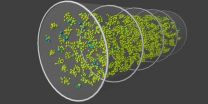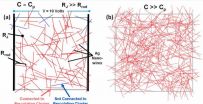(Press-News.org) We all know intuitively that normal liquids flow more quickly as the channel containing them tightens. Think of a river flowing through narrow rapids.
But what if a pipe were so amazingly tiny that only a few atoms of superfluid helium could squeeze through its opening at once? According to a longstanding quantum-mechanics model, the superfluid helium would behave differently from a normal liquid: far from speeding up, it would actually slow down.
For more than 70 years, scientists have been studying the flow of helium through ever smaller pipes. But only recently has nanotechnology made it possible to reach the scale required to test the theoretical model, known as the Tomonaga-Luttinger theory (after the scientists who developed it).
Now, a team of McGill University researchers, with collaborators at the University of Vermont and at Leipzig University in Germany, has succeeded in conducting experiments with the smallest channel yet - less than 30 atoms wide. In results published online today in Science Advances, the researchers report that the flow of superfluid helium through this miniature faucet does, indeed, appear to slow down.
"Our results suggest that a quantum faucet does show a fundamentally different behaviour," says McGill physics professor Guillaume Gervais, who led the project. "We don't have the smoking gun yet. But we think this a great step toward proving experimentally the Tomonaga-Luttinger theory in a real liquid."
The zone where physics changes
Insights from the research could someday contribute to novel technologies, such as nano-sensors with applications in GPS systems. But for now, Gervais says, the results are significant simply because "we're pushing the limit of understanding things on the nanoscale. We're approaching the grey zone where all physics changes."
Prof. Adrian Del Maestro from the University of Vermont has been employing high-performance computer simulations to understand just how small the faucet has to be before this new physics emerges. "The ability to study a quantum liquid at such diminutive length scales in the laboratory is extremely exciting as it allows us to extend our fundamental understanding of how atoms cooperate to form the superfluid state of matter," he says. "The superfluid slowdown we observe signals that this cooperation is starting to break down as the width of the pipe narrows to the nanoscale" and edges closer to the exotic one-dimensional limit envisioned in the Tomonaga-Luttinger theory.
Building what is probably the world's smallest faucet has been no simple task. Gervais hatched the idea during a five-minute conversation over coffee with a world-leading theoretical physicist. That was eight years ago. But getting the nano-plumbing to work took "at least 100 trials -- maybe 200," says Gervais, who is a fellow of the Canadian Institute for Advanced Research.
A beam of electrons as drill bit
Using a beam of electrons as a kind of drill bit, the team made holes as small as seven nanometers wide in a piece of silicon nitride, a tough material used in applications such as automotive diesel engines and high-performance ball bearings. By cooling the apparatus to very low temperatures, placing superfluid helium on one side of the pore and applying a vacuum to the other, the researchers were able to observe the flow of the superfluid through the channel. Varying the size of the channel, they found that the maximum speed of the flow slowed as the radius of the pore decreased.
The experiments take advantage of a unique characteristic of superfluids. Unlike ordinary liquids - water or maple syrup, for example -- superfluids can flow without any viscosity. As a result, they can course through extremely narrow channels; and once in motion, they don't need any pressure to keep going. Helium is the only element in nature known to become a superfluid; it does so when cooled to an extremely low temperature.
An inadvertent breakthrough
For years, however, the researchers were frustrated by a technical glitch: the tiny pore in the silicon nitride material kept getting clogged by contaminants. Then one day, while Gervais was away at a conference abroad, a new student in his lab inadvertently deviated from the team's operating procedure and left a valve open in the apparatus. "It turned out that this open valve kept the hole open," Gervais says. "It was the key to getting the experiment to work. Scientific breakthroughs don't always happen by design!"
INFORMATION:
Prof. Bernd Rosenow, a quantum physicist at Leipzig University's Institute for Theoretical Physics, also contributed to the study.
Partners in research:
This work was funded by the Natural Sciences and Engineering Research Council of Canada (NSERC), the Fonds de recherche du Québec - Nature et technologies (FRQNT), and the Canadian Institute for Advanced Research (CIFAR). Polytechnique Montréal provided access to a facility where the hole was made for the experiment. Computer simulations were performed at the Vermont Advanced Computing Core.
"Critical flow and dissipation in a quasi-one-dimensional superfluid," Pierre-François Duc, Michel Savard, Matei Petrescu, Bernd Rosenow, Adrian Del Maestro, Guillaume Gervais. Science Advances, published online May 15, 2015. 10.1126/sciadv.1400222
Additional Contact:
Joshua Brown
University of Vermont
802-656-3039
joshua.e.brown@uvm.edu
The MODIS instrument on the Aqua satellite captured this image of the Little Bobtail Lake fire in British Columbia, Canada. It is unclear how the fire started and was first spotted on Saturday, May 9. Since then the fire has grown significantly and has burned over 13,000 hectares (32,123 acres) and is zero percent con The wildfire is located about 70 km southwest of Prince George. Eighty people have already been evacuated and close to 700 homes are in danger of being consumed should the fire spread.
British Columbia Wildfire Management reports that the fire is unpredictable ...
Washington D.C. - Friday, May 15, 2015- Investigators found that nearly half of the 50 chicken meat samples purchased from supermarkets, street markets, and butchers in Austria contained viruses that are capable of transferring antibiotic resistance genes from one bacterium to another--or from one species to another. "Our work suggests that such transfer could spread antibiotic resistance in environments such as food production units and hospitals and clinics," said corresponding author Friederike Hilbert, DVM. The research is published ahead of print May 1, in Applied ...
At the forefront of a field known as "neurocriminology," Adrian Raine of the University of Pennsylvania has long studied the interplay between biology and environment when it comes to antisocial and criminal behavior. With strong physiological evidence that disruption to the emotion-regulating parts of the brain can manifest in violent outbursts, impulsive decision-making and other behavioral traits associated with crime, much of Raine's research involves looking at biological interventions that can potentially ward off these behavioral outcomes.
A new study by Raine ...
An article, "Smaller amygdala and medial prefrontal cortex predict escalating stimulant use," published online on May 13 in Brain: A Journal of Neurology has found that individual differences in brain structure could help to determine the risk for future drug addiction. The study found that occasional users who subsequently increased their drug use compared with those who did not, showed brain structural differences when they started using drugs.
In the two studies, researchers, led by Dr. Benjamin Becker, scanned the brain structure of 66 participants to provide the ...
NEW YORK, May 15, 2015 -- National thought leaders convened at Columbia University's Mailman School of Public Health yesterday for a symposium identifying gaps in understanding the prevention of sexual violence on college campuses, calling for a broad interdisciplinary agenda for the next generation of research on a significant problem that became front-page news around the country this year.
The day-long event, "Transforming the Campus Climate: Interdisciplinary Perspectives on Sexual Violence," was one of the first public activities sponsored by the Sexual Health Initiative ...
The future of communities around the world will in large part be determined by the efforts to achieve a high quality of life for their older citizens, according to the latest issue of Public Policy & Aging Report (PP&AR), titled "Making a Home in the City: The Age-Friendly Community Movement." A total of seven articles argue that developing cities that meet the interests of all generations should be an important goal for economic and social policy.
"The concomitant growth of cities and of an older population within those cities has come to generate a disjuncture between ...
Boulder, Colo., USA - California and other parts of the western U.S. are experiencing extended severe drought conditions. Varying groundwater levels in valleys throughout the state, balanced by water imported, for instance, via the State Water Project and the federal Central Valley Project make understanding the state's underlying hydrologic framework all the more important. This paper by R.T. (Randy) Hanson of the U.S. Geological Survey focuses on California's Santa Clara Valley.
In the introduction to his paper, Hanson provides a succinct history of the area, as paraphrased ...
Researchers at Lehigh University have identified for the first time that a performance gain in the electrical conductivity of random metal nanowire networks can be achieved by slightly restricting nanowire orientation. The most surprising result of the study is that heavily ordered configurations do not outperform configurations with some degree of randomness; randomness in the case of metal nanowire orientations acts to increase conductivity.
The study, Conductivity of Nanowire Arrays under Random and Ordered Orientation Configurations, is published in the current issue ...
1. The "Radial Paradox": Higher Femoral Access Site Complications Offsets Radial Benefits
Growing acceptance of radial access during cardiac catheterisation to reduce access site complications may contribute to a loss of experience with femoral access, potentially increasing vascular complications when the femoral technique is used. Montreal Heart Institute researchers compared contemporary and historical patient cohorts (n=17,059) and found that vascular access complications today, using the femoral artery approach--used typically as a back-up method--are more common ...
No one health issue has the most impact on human health, or engenders more debate about how to tackle it, than obesity.
It has become the scourge of the health agenda, especially in the west, and it is a growing problem. According to the latest figures from the World Health Organisation, almost three-quarters of British men and two-thirds of women will be overweight or obese by 2030 - a staggering 39 million adults in total. We have one of the worst obesity records in Europe, with just six of the 52 countries in the WHO's European region with worse obesity rates for women.
We ...





